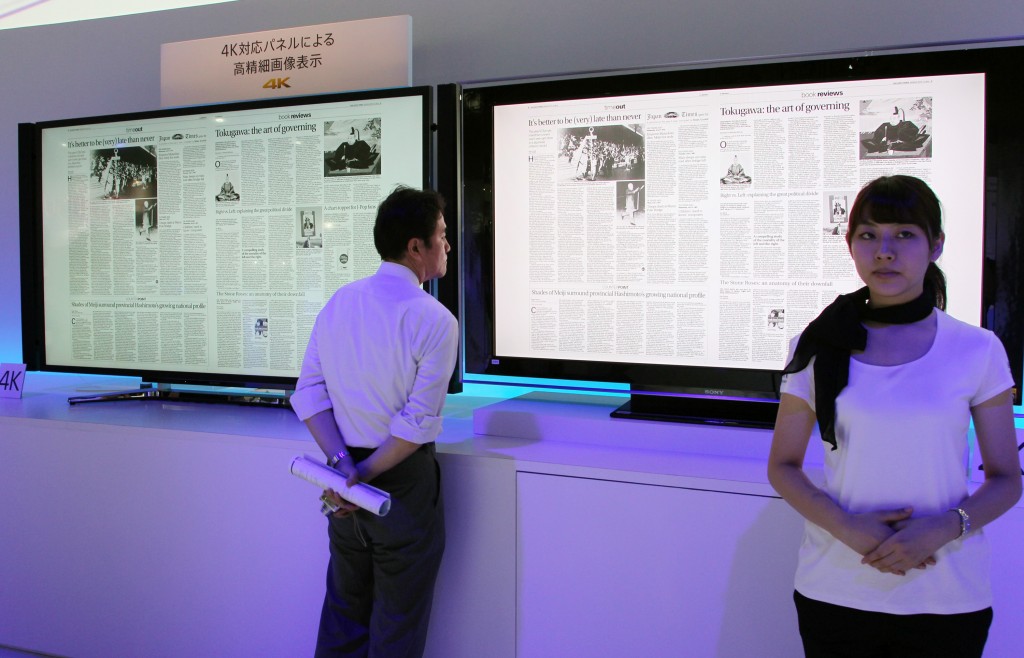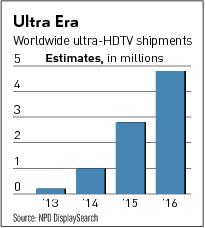
[PHOTO: Junko Kimura/Bloomberg via Getty Images]
Now manufacturers have dug deep into their bag of tricks to offer 4K HDTV, also known as Ultra HDTV…
We’re starting to hear the banging of the Ultra HDTV (or UHDTV) drum, as several reports have appeared in the media noting that Samsung, LG, and Sony will show large UHDTV sets at the International Consumer Electronics Show this January in Las Vegas. More and more media are noting the coming format – but the intensity of the enthusiasm of these reports is tepid at best. And in many cases, they are downright skeptical of the potential for the success of the new format.
A recent report on Investors.com – a site clearly targeted at an audience that would most likely be qualified to purchase a new UHDTV – announced the new format. And in just the second paragraph, the writer intoned:
“But don’t chuck your current TV just yet. It will take a few years for the new sets to reach mainstream pricing and for content to emerge that takes advantage of the higher-resolution screens.”
Warning, warning…no content…
A little later in the article, the reporter issues a more direct warning noting that, “Today there is no ultra HD content available…” Investors.com even quotes the CEA’s Steve Koenig as saying, “It’s going to take a while…” for UHDTV to take hold. “It will probably be the back half of this decade.”
Ultra HDTV has more than 8 million pixels or four times the resolution of today’s 1080p sets. Manufacturers hope that this higher resolution will encourage people to step up to larger screens which more readily show off the advantage of UHDTV technology. And – oh by the way – also happen to be more profitable for the manufacturer to sell as well.
Super duper ultra high definition television…
Earlier this year, we reported on a new higher resolution TV format out of Japan also known – confusingly – as Ultra HDTV, but with an even higher resolution than the 4K UHDTV about to be introduced in a couple of months. This format feature 33.2 megapixels or 16 times higher resolution then the current standard – and its founders are seeking to have it set as a worldwide standard.
Our report generated a slew of comments from readers who all questioned the need for UHDTV. Len Schneider asked, “But answer this: Where is the consumer benefit?” And reader Michael Riggs (former editor of several A/V magazines) noted that for most homes with 65-inch or smaller screens “1080p is completely adequate.”
Time to get on the bandwagon?…
 Still, NPD DisplaySearch, hopping on the UHDTV bandwagon, estimates that 1 million units will be sold in 2014. And by 2016, NPD predicts 4.8 million units will be sold representing almost 18 percent of the television market. How they come up with these estimates is a bit of a mystery…but they will undoubtedly spur on manufacturers to pursue this new Holy Grail.
Still, NPD DisplaySearch, hopping on the UHDTV bandwagon, estimates that 1 million units will be sold in 2014. And by 2016, NPD predicts 4.8 million units will be sold representing almost 18 percent of the television market. How they come up with these estimates is a bit of a mystery…but they will undoubtedly spur on manufacturers to pursue this new Holy Grail.
For this year and next, NPD says shipments will be tiny…mostly consisting of demo units sent to retailers to show. The market researcher says 4,000 units will ship this year and 154,000 units will be shipped in 2013.
Generous estimates…
Considering that the retail price on UHDTV runs around $20,000 retail…even these initial estimates seem generous. However, as is the common model in our idustry, the CEA anticipates that prices will come down rather quickly. The trade association says that UHDTV prices will come down to $7,000-$10,000 in 2013…and drop to $2,000-$2,500 in 2015. After 2016, the CEA says prices will drop below $2,000.
There are many questions about the viability of UHDTV. Many pieces of the puzzle have to come together to make it happen. First and foremost, content has to be created…and transmitted in a new format. It is unclear whether all the necessary constituents such as broadcasters, cable companies, satellite companies, etc. are ready to fall in line behind this latest industry gambit.
Some of these constituents were persuaded to invest – and invest heavily – in 3D. As this technology has fizzled – they may feel snake bit and less likely to give the industry the benefit-of-the-doubt next time.
RELATED POSTS
Forget 4K! Japanese Engineers Create New Global Standard – UHDTV





Leave a Reply